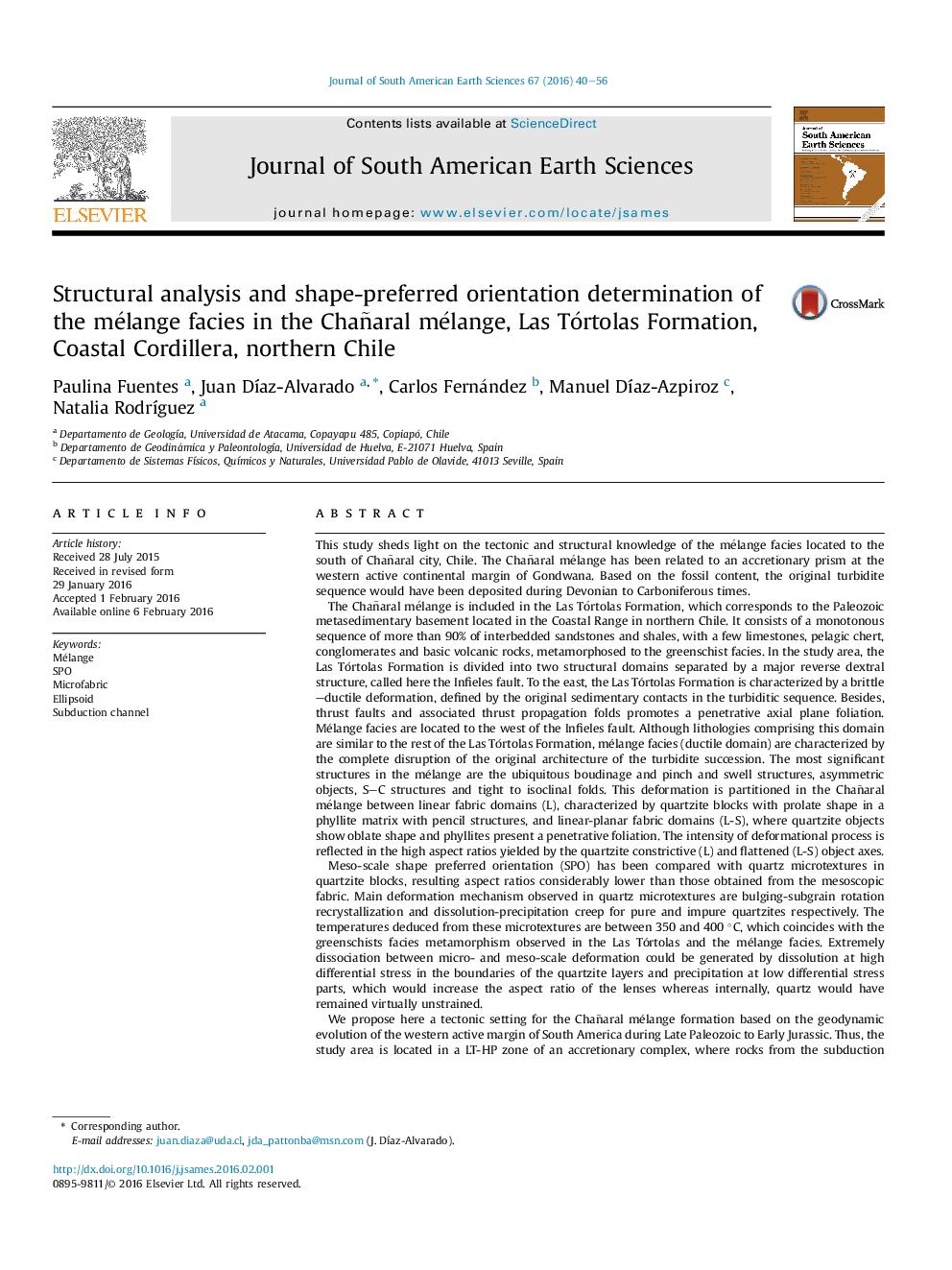| کد مقاله | کد نشریه | سال انتشار | مقاله انگلیسی | نسخه تمام متن |
|---|---|---|---|---|
| 4682009 | 1635143 | 2016 | 17 صفحه PDF | دانلود رایگان |

• Structural analysis of the Chañaral mélange included in the Las Tórtolas Formation.
• High intensity deformational process (D1–D2 phases) to conform mélange textures.
• Extremely dissociation between micro- and meso-scale deformation.
• Tectonic setting: LT-HP zone of an accretionary complex.
This study sheds light on the tectonic and structural knowledge of the mélange facies located to the south of Chañaral city, Chile. The Chañaral mélange has been related to an accretionary prism at the western active continental margin of Gondwana. Based on the fossil content, the original turbidite sequence would have been deposited during Devonian to Carboniferous times.The Chañaral mélange is included in the Las Tórtolas Formation, which corresponds to the Paleozoic metasedimentary basement located in the Coastal Range in northern Chile. It consists of a monotonous sequence of more than 90% of interbedded sandstones and shales, with a few limestones, pelagic chert, conglomerates and basic volcanic rocks, metamorphosed to the greenschist facies. In the study area, the Las Tórtolas Formation is divided into two structural domains separated by a major reverse dextral structure, called here the Infieles fault. To the east, the Las Tórtolas Formation is characterized by a brittle–ductile deformation, defined by the original sedimentary contacts in the turbiditic sequence. Besides, thrust faults and associated thrust propagation folds promotes a penetrative axial plane foliation. Mélange facies are located to the west of the Infieles fault. Although lithologies comprising this domain are similar to the rest of the Las Tórtolas Formation, mélange facies (ductile domain) are characterized by the complete disruption of the original architecture of the turbidite succession. The most significant structures in the mélange are the ubiquitous boudinage and pinch and swell structures, asymmetric objects, S–C structures and tight to isoclinal folds. This deformation is partitioned in the Chañaral mélange between linear fabric domains (L), characterized by quartzite blocks with prolate shape in a phyllite matrix with pencil structures, and linear-planar fabric domains (L-S), where quartzite objects show oblate shape and phyllites present a penetrative foliation. The intensity of deformational process is reflected in the high aspect ratios yielded by the quartzite constrictive (L) and flattened (L-S) object axes.Meso-scale shape preferred orientation (SPO) has been compared with quartz microtextures in quartzite blocks, resulting aspect ratios considerably lower than those obtained from the mesoscopic fabric. Main deformation mechanism observed in quartz microtextures are bulging-subgrain rotation recrystallization and dissolution-precipitation creep for pure and impure quartzites respectively. The temperatures deduced from these microtextures are between 350 and 400 °C, which coincides with the greenschists facies metamorphism observed in the Las Tórtolas and the mélange facies. Extremely dissociation between micro- and meso-scale deformation could be generated by dissolution at high differential stress in the boundaries of the quartzite layers and precipitation at low differential stress parts, which would increase the aspect ratio of the lenses whereas internally, quartz would have remained virtually unstrained.We propose here a tectonic setting for the Chañaral mélange formation based on the geodynamic evolution of the western active margin of South America during Late Paleozoic to Early Jurassic. Thus, the study area is located in a LT-HP zone of an accretionary complex, where rocks from the subduction channel (mélange facies) and the basal domain of the prism (brittle–ductile domain of the Las Tórtolas Formation) are in contact through the Infieles fault.
Figure optionsDownload as PowerPoint slide
Journal: Journal of South American Earth Sciences - Volume 67, April 2016, Pages 40–56